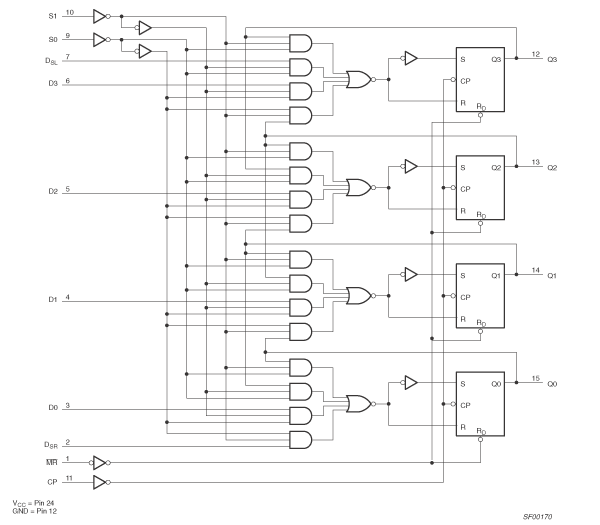
Serial 2 S Complementer Shift Register
First look at the operation of the D type flip flop The sequence starts by a reset so Q = 0 The input to the D-type is made up from the initial output (Q) which is OR'd with the first (LSB) bit of the number you are complimenting (X). The output Y is XOR'd with Q and X (00 > 0, 01 >1) as Q is '0' we don't have to consider any other case. So initially the output at Y will always be the same as input at X i.e our LSB data bit.
Trainz railroad simulator. 2013-12-11T08:27:26+00:00 daily 1.0.
To form the 2s complement (of 0000 1111 0000 1010 0000 0000 1111 1100). Homework: A 4-bit shift register initially contains 1101. It is shifted six times to the right with the serial input being 101101. What is the contents of the.
The initial input at 'D' will also be the same as the input at X (X OR '0' = X) Let's take a number - say 28. In binary this would be 00011100 To change this to its 2's compliment we invert and add 1 00011100 --> 11100011 ---> +1 ----> 11100100 So if our circuit works a 00011100 input it will produce a 11100100 output Start with a reset so that Y = X (Q = '0') Q (t+1) = D (t) D is X OR Q Y is X XOR Q LSB first X Q D Y 0 0 0 0 0 0 0 0 1 0 1 1 1 1 1 0 1 1 1 0 0 1 1 1 0 1 1 1 0 1 1 1 Look at the diagonal relationship between D and Q.
Q in the next row (t+1) is simply the value of D in the previous row (at time t). Each time the bit is CLOCKED 't' moves on 1. The rest is simply applying the logic of the connected gates to produce a value.
Arch #11 Computer Architecture Start Lecture #11 Homework: Read 3.1-3-4 3.1: Introduction I have nothing to add. 3.2: Signed and Unsigned Numbers MIPS uses 2s complement (just like 8086) To form the 2s complement (of 0000 1111 0000 1010 0000 0000 1111 1100) • Take the 1s complement. • That is, complement each bit (1111 0000 1111 0101 1111 1111 0000 0011) • Then add 1 (1111 0000 1111 0101 1111 1111 0000 0100) Need comparisons for signed and unsigned. • For signed a leading 1 is smaller (negative) than a leading 0 • For unsigned a leading 1 is larger than a leading 0 Comments on Two's Complement You could easily ask what does this funny notation have to do with negative numbers.

Let me make a few comments. • What does minus 1 mean? Ans: It is the unique number that, when added to 1, gives zero. • The binary number 1111.1111 has this property (using regular n-bit addition and discarding the carry-out) so we do seem to have -1 correct. • Just as n+1 (for n≥0) is defined as the successor of n, -(n+1) is the number that has -n as successor. That is we need to show that TwosComp(n+1) + 1 = TwosComp(n).
• This would follow if we coud show OnesComp(n+1) + 1 = OnesComp(n), i.e, (n+1)' + 1 = n'. • Let n be even, n = *0, * arbitrary. • Write n', n+1 and (n+1)' and see that it works. • Let n be odd, n = *01 s1, where 1 s just means a bunch of ones. • Again it works. • So for example TwosComp(6)+1=TwosComp(5) and hence TwosComp(6)+6=zero, so it really is -6.
Sltu and sltiu Like slt and slti but the comparison is unsigned. Homework: 3.1-3.6 3.3: Addition and subtraction To add two (signed) numbers just add them. That is, don't treat the sign bit special. To subtract A-B, just take the 2s complement of B and add. An overflow occurs when the result of an operation cannot be represented with the available hardware. For MIPS this means when the result does not fit in a 32-bit word.
• We have 31 bits plus a sign bit. • The result would definitely fit in 33 bits (32 plus sign) • The hardware simply discards the carry out of the top (sign) bit • This is not wrong--consider -1 + -1 11 (32 ones is -1) + 11 ---------------------------------- 110 Now discard the carry out 10 this is -2 • The bottom 31 bits are always correct. Overflow occurs when the 32 (sign) bit is set to a value and not the sign.
• Here are the conditions for overflow Operation Operand A Operand B Result A+B ≥ 0 ≥ 0 64 multiplier. What about the control? • Always give the ALU the ADD operation • Always send a 1 to the multiplicand to shift left • Always send a 1 to the multiplier to shift right • Pretty boring so far but • Send a 1 to write line in product if and only if LOB multiplier is a 1 • I.e. Send LOB to write line • I.e.